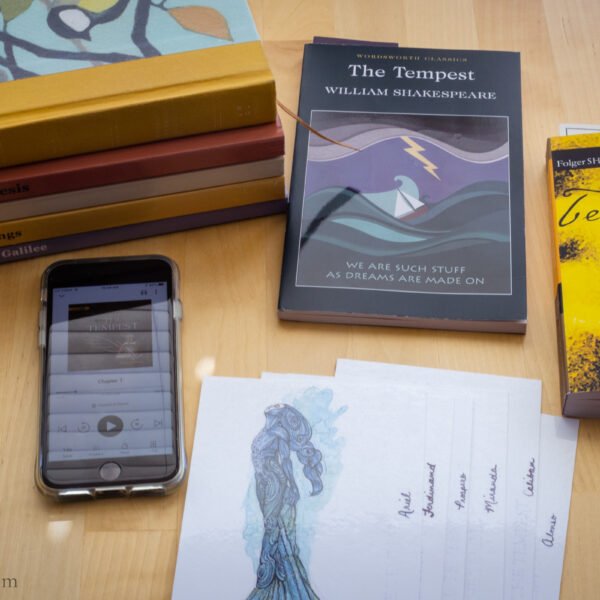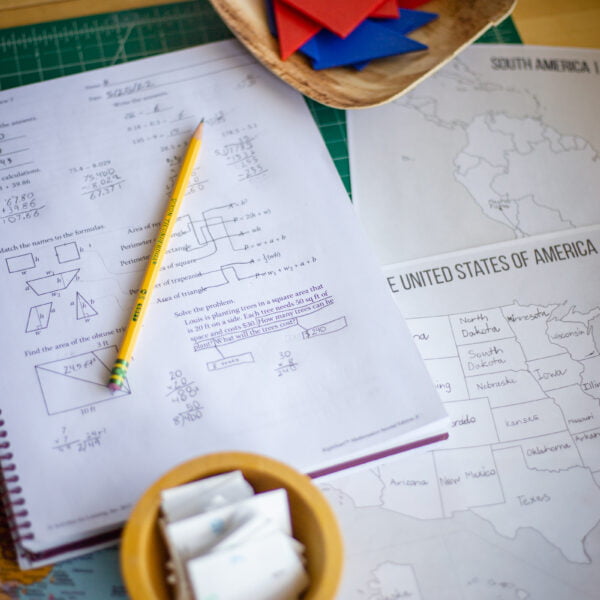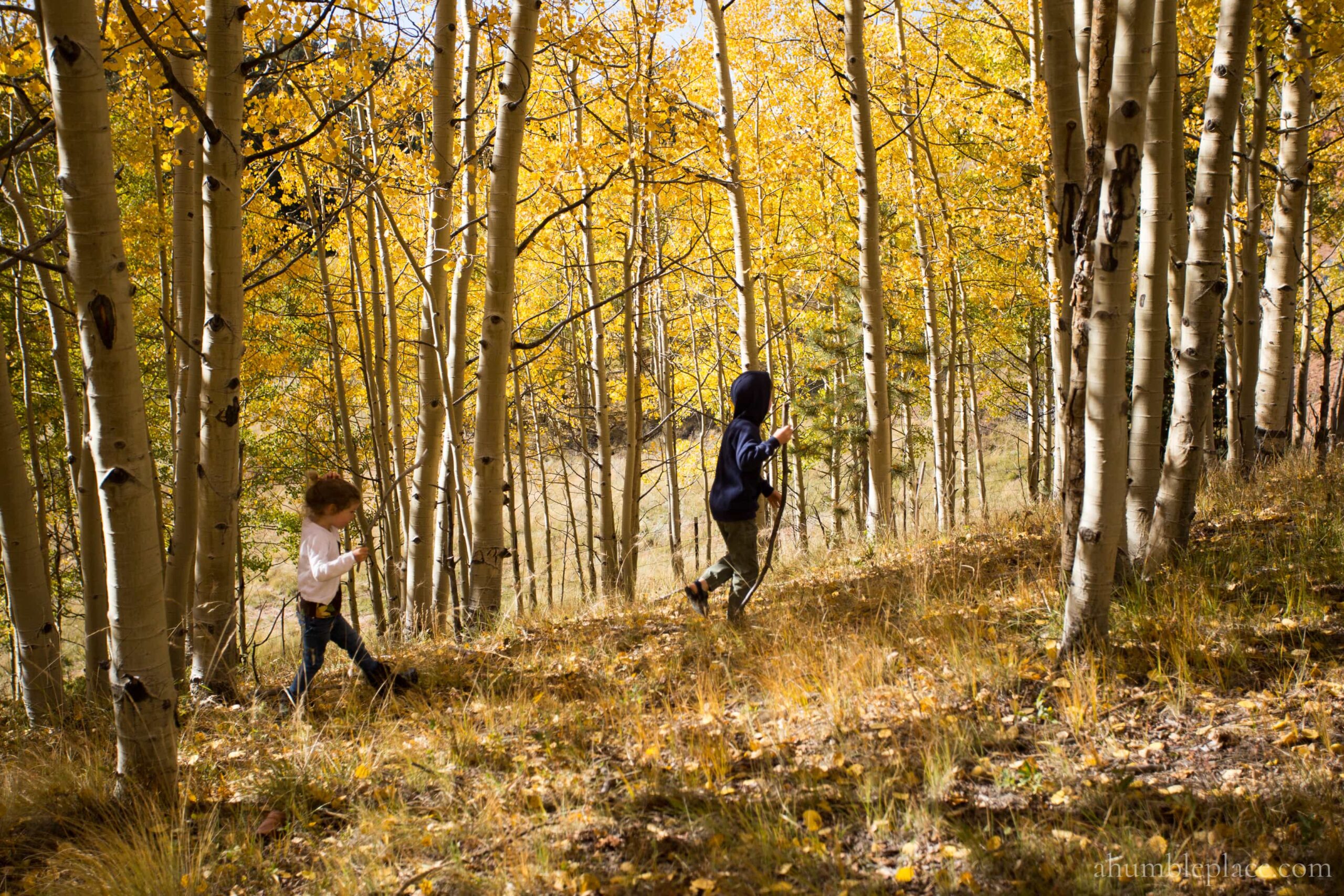My Favorite Resources for Charlotte Mason Homeschooling: Art and Handicrafts

Handicrafts are an important part of the Charlotte Mason method and not only teach useful skills, but can also allow them to hone their habit of perfect execution. Art creation encourages their creative instinct and also teaches fine motor skills.
In this post, I’m sharing some of my favorite Charlotte Mason art and handicraft ideas and resources! In the art category, I’m including the process of making art as well as studying art. As I’ve mentioned before, one of the reasons I was especially drawn to a Charlotte Mason Education was because of picture study, so this topic is particularly close to my heart!
Art
Picture Study
The art training of children should proceed on two lines. The six-year-old child should begin both to express himself and to appreciate, and his appreciation should be well in advance of his power to express what he sees or imagines. Therefore it is a lamentable thing when the appreciation of children is exercised only upon the coloured lithographs of their picture-books or of the ‘Christmas number.’ But the reader will say, ‘A young child cannot appreciate art; it is only the colour and sentiment of a picture that reach him. A vividly coloured presentation of Bobbie’s Birthday, or of Barbara’s Broken Doll, will find its way straight to his “business and bosom.”‘ ‘Therefore,’ says the reader, ‘Nature indicates the sort of art proper for the children!’ But, as a matter of fact, the minds of children and of their elders alike accommodate themselves to what is put in their way; and if children appreciate the vulgar and sentimental in art, it is because that is the manner of art to which they become habituated.
CHARLOTTE MASON (HOME EDUCATION)
How do we prepare a child, again, to use the aesthetic sense with which he appears to come provided? His education should furnish him with whole galleries of mental pictures, pictures by great artists old and new;––Jozef Israels’ Pancake Woman, his Children by the Sea; Millet’s Feeding the Birds, First Steps, Angelus; Rembrandt’s Night Watch, The Supper at Emmaus; Velasquez’s Surrender of Breda,––in fact, every child should leave school with at least a couple of hundred pictures by great masters hanging permanently in the halls of his imagination, to say nothing of great buildings, sculpture, beauty of form and colour in things he see. Perhaps we might secure at least a hundred lovely landscapes too,––sunsets, cloudscapes, starlight nights. At any rate he should go forth well furnished because imagination has the property of magical expansion, the more it holds the more it will hold.
CHARLOTTE MASON (Philosophy of Education)
Resources
Charlotte Mason Picture Study Aids
Charlotte Mason Picture Study Video: Vincent van Gogh’s “The Bedroom”
Articles
Why is picture study important?
How to do Picture Study
How to Print Picture Study Art
How to Display Picture Study Art
‘Picture Study’ by E.C. Plumptre
Myth: The Point Of Composer Study And Picture Study Is To Know About Composers And Artists As Individual Persons
If you’ve been reading here for a while, you know that I’ve already written quite a bit about picture study. So instead of repeating myself, I linked to several posts I have published about picture study on my website for you to read at your leisure.
There are just a few things to keep in mind with picture study, the most important one being to keep it simple. All you really need for picture study is quiet time to look at a piece of art followed by narration. Discussion is optional. Reading an artist biography is optional. Everything else is optional.
One artist is studied over the course of a term (or 12 weeks) by looking at six of their pieces, two weeks per piece. I usually like to print out a picture of our artist and composer for the term and hang them in our school area. You can see an overview of how we do each week here. I have also linked to a video I made a few years ago of a typical picture study session in both our home and our homeschool co-op when we were still part of that.
Picture study allows your students to develop relationships with art, so setting aside intentional time for this each week is very important. As I mentioned above, it doesn’t have to be complicated and can actually be a time of good conversation and sharing!
Making Art
With art, as with so many other things in a child, we must believe that it is there, or we shall never find it. Once again, here is a delicate Ariel whom it is our part to deliver from his bonds. Therefore we set twig or growing flower before a child and let him deal with it as he chooses. He will find his own way to form and colour, and our help may very well be limited at first to such technical matters as the mixing of colours and the like. In order that we may not impede the child’s freedom or hinder the deliverance of the art that is in him, we must be careful not to offer any aids in the way of guiding lines, points, and such other crutches; and, also, he should work in the easiest medium, that is, with paint brush or with charcoal, and not with a black-lead pencil. Boxes of cheap colours are to be avoided. Children are worthy of the best, and some half-dozen tubes of really good colours will last a long time, and will satisfy the eye of the little artists.
CHARLOTTE MASON (HOME EDUCATION)
Resources
What to Draw and How To Draw It
Brushwork
Brush Drawing: A Basic Course
Creating a Masterpiece
Lily & Thistle Watercolor School
Anna Mason Art
Articles
‘Drawing Lessons’ by Florence Monkhouse
‘Early Drawing Lessons’ by Lucy Gore (also discusses brush drawing)
Because of my experience with the studio art classes I took in college for my art history degree, I was initially very hesitant to begin any formal art instruction with my kids. Both have enjoyed making art from a very young age, and I didn’t want to kill that instinct in them by introducing a drawing program that made them change the way they created art. I firmly believe that art is a very personal thing, and often the process is more important than the product, especially for young children.
Keeping drawing simple worked well for us for a few years, but my kids got older, I decided that perhaps a gentle drawing program wasn’t a bad idea as several other families in our co-op included drawing lessons in their weekly schedule, which helped with their nature notebook drawings. I began researching, and a few books were suggested in the AmblesideOnline forums, but when I got them from the library, they were far more complicated than I wanted. I searched for online options, but most of them were out of our budget or, again, more involved than what I wanted. Ironically (or logically? :)), I finally found the book for us when I looked at Programme 94 and the books used for Form I students. What to Draw and How to Draw It was listed, and I was able to find it on Archive. It was pretty much exactly what I wanted, and Living Book Press had just re-printed it, so I picked up a copy for us.
When I presented it to my son, I emphasized that this wasn’t the only way to draw, but perhaps it could teach him alternative ways to make art that might improve his skills. We started with just one series per week, and he finished the book in about two years.
Another change to our art-making experience began through our homeschool co-op. A few years into it, the mom in charge of handicrafts decided we would do a video series from Creating a Masterpiece on pastels that year, including one project to create a mountain scene. It was a challenge for my son, but he was mostly happy with the results and learned more about technique and using a medium we would not have otherwise used. This allowed me to see the value in using structured art lessons taught through videos and is something I hope to include in the future.
I did include brushdrawing in our lessons after a wonderful and extremely helpful talk and demonstration that Karen Canon did at our retreat in 2019. Our retreat leader, Dawn, put together a bundle of brush drawing supplies using the Brushwork book linked above that we sold at the retreat, so we began doing that in Term 3 of that year. He did very well with it into the following year, but I decided in 2020 not to continue doing that and drawing simultaneously due to time constraints. However, now that he is finished with the drawing book, I am entertaining starting brush drawing in the fall again if we do not do a video course.
I want to note that in the quote above, she recommends using charcoal instead of pencils. However, What to Draw and How to Draw It mentions using pencils specifically, and the PR article linked above (“Early Drawing Lessons”) also mentions using pencils (and actually emphasizes using several different types of media). We have used pencils in our drawing lessons as I find charcoal very messy and, honestly, challenging to work with without getting everywhere.
I have a few resources listed there that we have either used ourselves (What to Draw and How To Draw It, Brushwork, Creating a Masterpiece) or about which I have heard good things. Brush Drawing: A Basic Course was done by Richele Baburina, who I also mentioned in my math post. I’ve participated in a few bundle sales with Lily & Thistle, so I’ve seen her products firsthand and appreciate how she incorporates a lot of nature into her art instruction. And Anna Mason Art is an online watercolor course my friend Karen did that might be good for older students.

Handicrafts
The Handicrafts best fitted for children under nine seem to me to be chair-caning, carton-work, basket-work, Smyrna rugs, Japanese curtains, carving in cork, samplers on coarse canvas showing a variety of stitches, easy needlework, knitting (big needles and wool), etc. The points to be borne in mind in children’s handicrafts are: (a) that they should not be employed in making futilities such as pea and stick work, paper mats, and the like; (b) that they should be taught slowly and carefully what they are to do; (c) that slipshod work should not be allowed; (d) and that, therefore, the children’s work should be kept well within their compass.
CHARLOTTE MASON (HOME EDUCATION)
…we know that the human hand is a wonderful and exquisite instrument to be used in a hundred movements exacting delicacy, direction and force; every such movement is a cause of joy as it leads to the pleasure of execution and the triumph of success. We begin to understand this and make some efforts to train the young in the deft handling of tools and the practice of handicrafts. Some day, perhaps, we shall see apprenticeship to trades revived, and good and beautiful work enforced. In so far, we are laying ourselves out to secure that each shall “live his life”; and that, not at his neighbour’s expense; because, so wonderful is the economy of the world that when a man really lives his life he benefits his neighbour as well as himself; we all thrive in the well-being of each.
CHARLOTTE MASON (Philosophy of Education)
Resources
Nourishing Traditions Cookbook for Children Handicraft Printable
Paper Sloyd: A Handbook for Primary Grades (another option as a more basic introduction to paper crafts is Easy Origami)
A Manual of Clay-Modelling (Dawn Rhymer also began writing a series about how we did this in our co-op)
Sewing School
Complete Guide to Soap Carving (which is also a great introduction to wood carving!)
Beeswax Alchemy
Recommendations for Handicrafts (with instructions)
Charlotte Mason Series #8 – Handicrafts and Life Skills
Articles
AmblesideOnline Overview and Recommendations for Handicrafts
Handicrafts and Life Skills (with more ideas for handicrafts)
I love the idea of handicrafts, but executing them has been challenging for me. When I had younger children and we were still in our homeschool co-op, another mom was in charge of them, and beautiful things were learned and made. And even the first term of our first year doing handicrafts at home went well. But then it kind of became less of a priority when life was busy, and only a few things have been done here and there ever since.
Ideally, when I pick our handicrafts, I usually look for things that my kids have shown interest in or that I think are practical skills that would be good for them to know. So that first term, we learned about healthy food and cooked meals together, which gave us a sense of accomplishment. This last term, we started our garden, so I let them pick out plants to tend, and I ordered gardening books to add to our home library. We’ve been talking quite a bit about emergency preparedness recently, so for next year, I was looking at going through a children’s wilderness survival book with them. I honestly love that we can pick a different handicraft for each term and our choices are limitless.
I think the key for me personally with our handicraft lessons is that I have to get all of the supplies I’ll need for the term in advance, and I need to schedule intentional time for us to work on our handicrafts in the afternoon. This has become more evident as my daughter has gotten older since she is less of a self-starter than her brother has always been. This isn’t necessarily a bad thing, as I think it’s good for me to be involved as well (and it’s also a learning opportunity for me!), but I need to realize that I can’t be as lax about it as I have been in the past. I am hoping that eventually, they will get to the point where they will be working on their handicrafts on their own, but we aren’t there yet.
The resources I linked above are a few we’ve used over the last six years. Of the handicrafts we’ve done at home, the term in which we used The Nourishing Traditions Cookbook for Children was our most successful. Before I realized I didn’t need to do handicrafts at home and in co-op, we also did some paper sloyd work during my son’s Year 1. Clay Modeling was something we did in co-op, which resulted in many little clay figures of fruits and vegetables floating around my house. Sewing School was a book that I handed to my son when he showed an interest in learning to sew, and he did many of the projects on his own. Soap carving was less successful, but he did complete a few of those projects. And Beeswax Alchemy was one we tried to do this last year, and I’m hoping to return to in the future.
So what would you add to these lists? What art and handicraft resources have been indispensable for you?
In my next post in this series, I’ll be sharing our favorite resources for music and physical education! If you’re not signed up for my newsletter, click here to get a notification when the new post is available!
Other posts in this series:


















